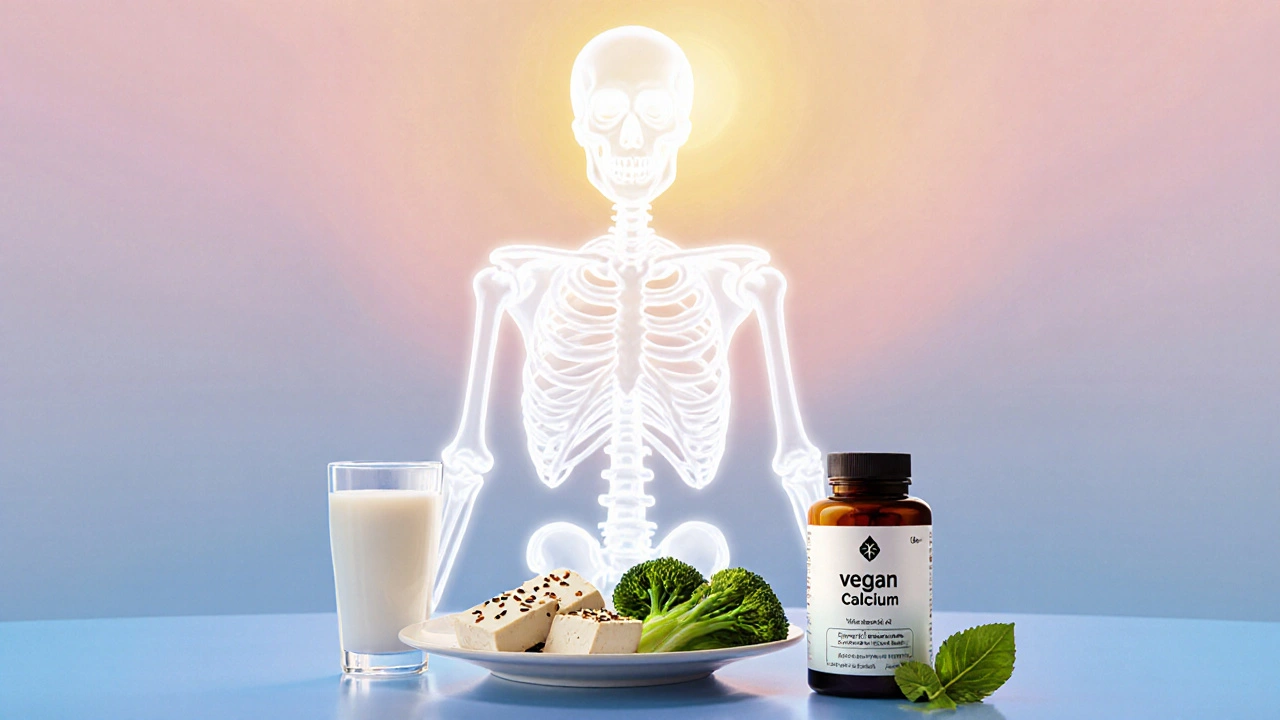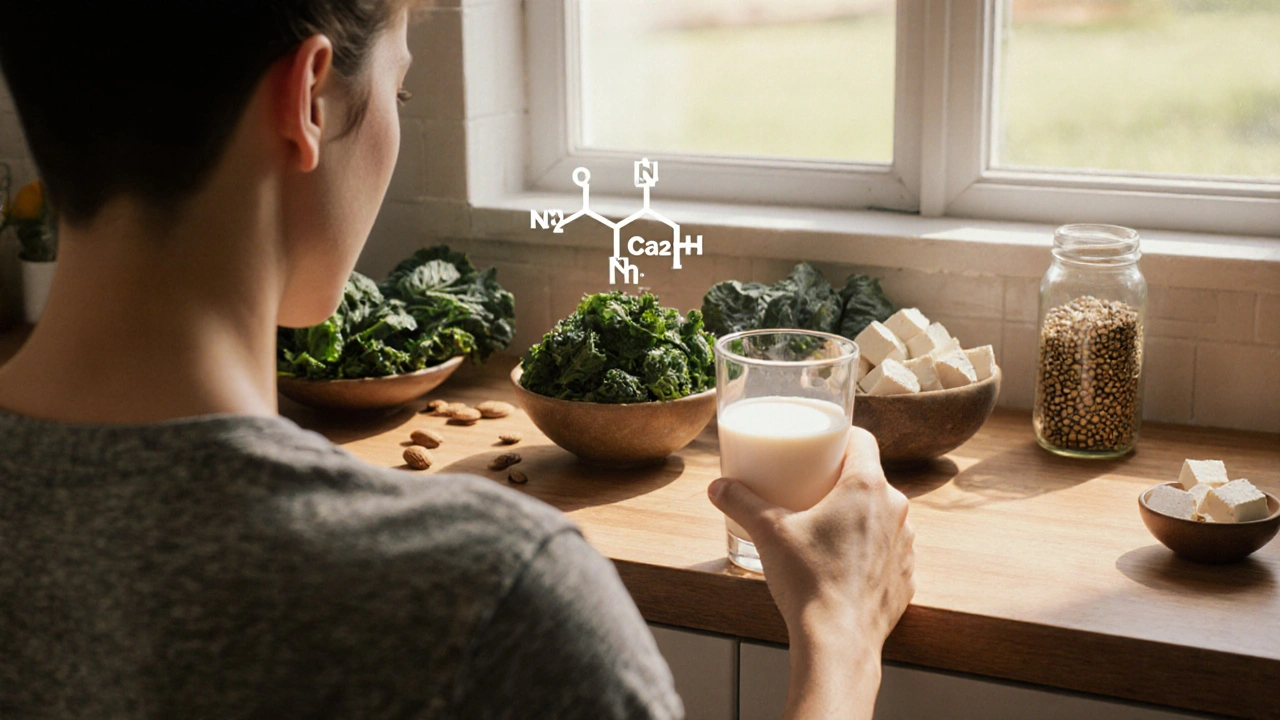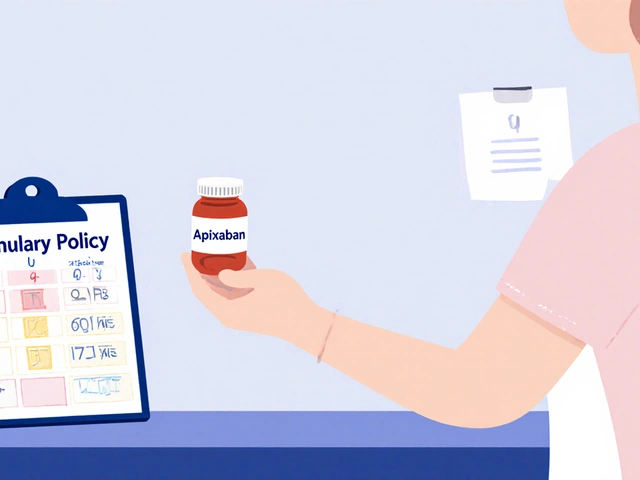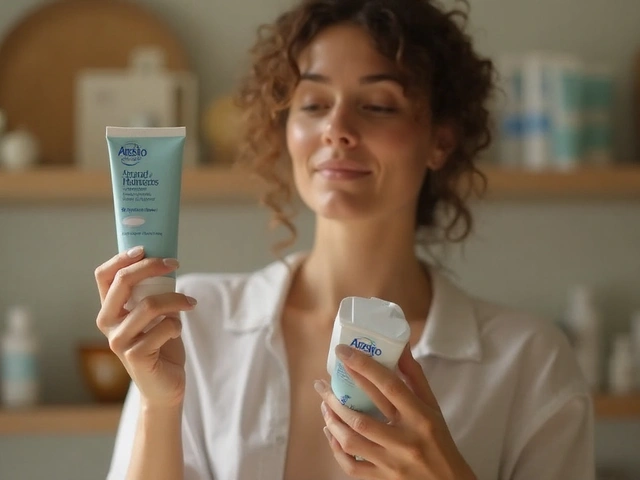When you switch to a plant‑based lifestyle, the biggest mineral that trips many people up is calcium. Calcium is a mineral essential for bone strength, muscle contraction, nerve signaling and blood clotting. Because dairy products are the most common calcium source in Western diets, vegans often wonder whether they can hit the recommended intake without cheese and milk.
Key Takeaways
- Vegans need 1,000mg of calcium daily (1,300mg for adults over 50); this can be met with whole foods, fortified products, and supplements.
- Leafy greens, tofu, beans, nuts, and seeds provide usable calcium, but oxalates and phytates can limit absorption.
- VitaminD, magnesium, and a low‑oxalate meal plan boost the amount of calcium your body actually uses.
- Fortified plant milks, juices, and breakfast cereals deliver calcium comparable to cow’s milk.
- A well‑chosen vegan calcium supplement can fill the gap on days when food sources fall short.
Why Calcium Matters for Everyone
Calcium accounts for about 2% of total body weight, yet 99% of it lives in bones and teeth. Your skeleton acts as a calcium reservoir, releasing the mineral when blood levels dip. If you consistently fall short, bone density can decline, leading to osteopenia or osteoporosis later in life. Even for athletes and active adults, calcium supports muscle contraction and recovery, making it a non‑negotiable nutrient.
Typical Gaps in a Vegan Diet
Most vegans do get calcium from vegetables, but two hidden factors often cause a shortfall:
- Oxalates in foods like spinach and Swiss chard bind calcium, making it unavailable for absorption.
- Phytates in beans, nuts, and whole grains act the same way, especially when meals are heavy on these foods.
Combine those binding agents with a lack of sunlight‑derived vitaminD, and the body’s ability to pull calcium from the diet drops sharply.
Plant‑Based Calcium Powerhouses
Here are the top whole‑food sources, listed with average calcium per 100g and a quick tip to lower oxalate or phytate impact.
| Food | Calcium (mg) | Oxalate/Phytate Note |
|---|---|---|
| Collard greens (cooked) | 232 | Low oxalate |
| Kale (raw) | 150 | Low oxalate |
| Fortified soy milk | 300 | Fortified |
| Tofu (calcium‑set) | 350 | High calcium, low oxalate |
| Almonds | 264 | Moderate phytate, soak to reduce |
| White beans (cooked) | 160 | Phytate - rinse well |
| Sesame seeds (hulled) | 975 | High calcium, soak before use |
| Broccoli (steamed) | 47 | Low oxalate |
Even a modest portion of these foods can get you close to the daily goal. For instance, a cup of fortified soy milk (≈240ml) provides about 300mg of calcium, while a ½‑cup of calcium‑set tofu adds another 175mg.
Boosting Calcium Absorption
Getting calcium into your bloodstream is a two‑step game: eat calcium‑rich foods, then create the right environment for absorption.
- VitaminD increases intestinal calcium uptake. Aim for 600-800IU daily from sunlight (10‑15minutes mid‑day exposure) or fortified foods. In winter or high‑latitude locations, a veg‑friendly vitaminD3 (derived from lichen) is reliable.
- Magnesium works hand‑in‑hand with calcium for bone mineralization. Nuts, seeds, whole grains, and dark chocolate supply it.
- Limit high‑oxalate foods (spinach, beet greens, rhubarb) on calcium‑heavy meals; swap them for low‑oxalate greens like bok choy, kale, or collards.
- Soak, sprout, or ferment beans, nuts, and grains to reduce phytate levels, thereby freeing more calcium for absorption.
Fortified Foods and Supplements: The Safety Net
Fortified plant milks, orange juice, and breakfast cereals often contain 300-450mg of calcium per serving-comparable to a glass of cow’s milk. Look for products that also add vitaminD; the combination is the most efficient way to meet the RDA.
If you struggle to hit 1,000mg on most days, consider a vegan calcium supplement. Choose calcium carbonate (high elemental calcium) or calcium citrate (easier on the stomach). A 500‑mg tablet taken with a vitaminD‑rich meal can bridge a 200‑400mg shortfall without overloading the diet.

Sample One‑Day Vegan Menu (≈1,100mg Calcium)
- Breakfast: 250ml fortified soy milk (300mg) + oatmeal topped with 2tbsp chia seeds (180mg) and fresh berries.
- Snack: Handful of almonds (80mg).
- Lunch: Kale‑collard salad with 100g tofu (350mg), shredded carrots, lemon‑tahini dressing, and a side of quinoa.
- Afternoon snack: Fortified orange juice (250ml → 250mg).
- Dinner: Stir‑fried broccoli and bok choy with sesame seeds (1tbsp → 100mg) served over brown rice.
Adjust portion sizes or add a supplement if you’re over 50, pregnant, or have a medical condition that raises calcium needs.
Common Pitfalls and How to Avoid Them
- Relying on high‑oxalate greens: They’re nutritious but lock up calcium. Pair them with a calcium‑rich side.
- Skipping vitaminD: Even the best diet can’t compensate for a deficiency in this fat‑soluble vitamin.
- Not reading fortification labels: Some brands market themselves as “vegan” but forget to add calcium.
- Taking too many supplements: Excess calcium can lead to kidney stones; stick to the recommended dosage.
Frequently Asked Questions
Can I get enough calcium from fruits alone?
Fruits are generally low in calcium. Oranges and figs provide some, but you’d need unrealistic quantities. Pair fruits with calcium‑rich foods or fortified products to meet the RDA.
Is calcium carbonate or calcium citrate better for vegans?
Calcium carbonate offers more elemental calcium per tablet, but it requires stomach acid for optimal absorption. Calcium citrate works well for people with low stomach acid and can be taken with or without food. Both are vegan‑friendly if derived from non‑animal sources.
How much vitaminD do I need on a vegan diet?
Adults should aim for 600-800IU daily. If you get limited sun, a daily supplement of 1,000IU vegan D3 (lichen‑derived) is a safe choice.
Do calcium‑rich beans cause bloating?
Beans contain fiber and oligosaccharides that can cause gas. Soaking, rinsing, and cooking them well reduces the effect. Pair with ginger or fennel for extra comfort.
Is calcium more important than vitaminK2 for bone health?
Both are essential. Calcium builds the bone matrix, while vitaminK2 helps direct calcium into bone rather than arteries. Vegans can obtain K2 from fermented foods like natto.




kevin muhekyi
October 9, 2025 AT 20:13Calcium isn’t just about dairy – plants can pack a punch if you choose wisely.
Leafy greens like collard and kale give you solid amounts without the oxalate baggage.
Fortified soy or almond milks are practically a dairy equivalent, especially when they also add vitamin D.
Soaking beans and nuts reduces phytates and frees up more calcium for your body.
Pair these foods with a bit of magnesium and you’ve got a well‑rounded bone‑supporting plan.
Teknolgy .com
October 13, 2025 AT 20:13Nice list, but who's counting? 🤷
Caroline Johnson
October 17, 2025 AT 20:13So you think a quick glance at a table and a smirk is sufficient, huh?
Calcium on a vegan diet is not a joke, it's a biochemical battlefield.
Your casual dismissal ignores the fact that oxalates can bind up to 80% of the mineral in spinach.
Meanwhile, phytates in beans act like tiny lock‑pick guards, preventing absorption unless you soak or sprout.
You also neglect vitamin D, the hormonal key that flips the intestinal doors open.
Without adequate D3, even the best‑fortified soy milk will sit idle in the gut.
And let's not forget magnesium; the silent partner that coordinates with calcium to build hydroxyapatite crystals.
A diet heavy in processed vegan cheeses often substitutes calcium carbonate with calcium citrate for a reason-bioavailability.
Your emoji‑rich shorthand fails to address the real risk of kidney stones from excess supplemental calcium.
Studies show that taking more than 2,000 mg daily can tip the balance toward calcification of soft tissues.
So when you advise newbies to just 'drink some plant milk' you are glossing over a cascade of nutritional interactions.
The nuance lies in timing meals low in oxalates, pairing them with vitamin D sources, and perhaps a modest supplement.
If you truly care about bone health, you must also monitor vitamin K2, which redirects calcium to bone matrix rather than arteries.
Vegans can obtain K2 from natto, fermented soy, or artisanal tempeh, not just kale.
In short, your breezy attitude is dangerous; respect the science, respect your bones.
Megan Lallier-Barron
October 21, 2025 AT 20:13While the data is solid, I can't help but wonder if the obsession with numbers distracts from enjoying food 🌱.
Everyone seems to treat calcium like a math problem, yet taste and tradition matter too 😊.
Perhaps a relaxed approach, eating a variety of greens, works just as well.
After all, wellness is as much about mindset as minerals.
Kelly Larivee
October 25, 2025 AT 20:13Different cultures have their own calcium tricks.
In many Asian kitchens, tofu set with calcium sulfate is a staple.
It’s a tasty way to keep bones strong without dairy.
Emma Rauschkolb
October 29, 2025 AT 20:13Your mention of tofu aligns with the concept of bioavailable calcium complexes – essentially Ca²⁺ ions chelated within a protein matrix 😎.
When you soak almonds, you’re hydrolyzing phytate esters, which in turn ↑ Ca²⁺ bioavailability 📈.
This enzymatic modulation is why fermentation protocols are championed in nutrigenomics circles 🤓.
Keep those emotes coming, they’re the spice of scientific discourse 😂.
Kaushik Kumar
November 2, 2025 AT 20:13Great job highlighting the soaking tip! It’s amazing how a simple 4‑hour soak can cut phytates by half, making calcium more accessible.
Keep experimenting with sprouting – a handful of sprouts adds both crunch and mineral power.
Remember, consistency is key, so make these steps a regular part of your meal prep.
Mara Mara
November 6, 2025 AT 20:13I appreciate the enthusiasm, but let’s ensure the facts stay accurate.
The average calcium content in fortified soy milk is about 300 mg per cup, not 500 mg.
Also, vitamin D‑3 derived from lichen is the only truly vegan source; many products still use D‑2, which is less effective.
Keeping these distinctions clear helps fellow vegans make informed choices.
Jennifer Ferrara
November 10, 2025 AT 20:13Esteemed colleagues, I would like to proffer a contemplative observation regarding the interplay of calcium and vitamin K2 within the skeletal matrix.
It is widely recognized that K2 facilitates the proper deposition of calcium, thereby mitigating arterial calcification.
Nevertheless, the prevalence of K2‑rich fermented edibles amongst vegan populations remains suboptimal.
A concerted effort to incorporate natto or similar cultures could conceivably enhance osseous health.
Apologies for any inadvertent orthographic errors herein.
Terry Moreland
November 14, 2025 AT 20:13That’s a thoughtful point, and I completely agree.
Emphasizing fermented foods is a practical step that anyone can add to their routine.
Even a small serving of natto a few times a week supplies both K2 and probiotic benefits.
Let’s keep sharing these easy hacks so the community can benefit.
Abdul Adeeb
November 18, 2025 AT 20:13While your sentiment is commendable, please note the correct placement of commas in your previous sentence.
The clause 'Even a small serving of natto...' should be set off with a comma after 'week' to improve readability.
Additionally, the term 'K2‑rich' requires a hyphen for proper compound adjective usage.
Precision in language mirrors precision in nutrition.
Abhishek Vernekar
November 22, 2025 AT 20:13Honestly, this whole calcium saga feels overhyped. If you eat a decent amount of greens, you’re fine. :)
Val Vaden
November 26, 2025 AT 20:13I understand the fatigue, but cutting corners can lead to hidden deficiencies.
A quick daily glance at the nutrition label of your plant milk can assure you’re meeting the target without extra hassle.
lalitha vadlamani
November 30, 2025 AT 20:13In closing, let us not be misled by the facile allure of minimalism when the stakes involve skeletal integrity.
The gravitas of calcium stewardship demands diligent attention, lest we surrender to the silent erosion of our very framework.